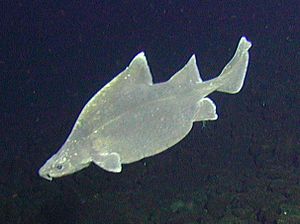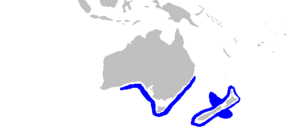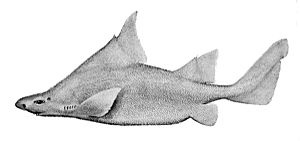Prickly dogfish facts for kids
Quick facts for kids Prickly dogfish |
|
|---|---|
 |
|
| Conservation status | |
| Scientific classification | |
| Genus: |
Oxynotus
|
| Species: |
bruniensis
|
 |
|
| Range of the prickly dogfish | |
| Synonyms | |
|
Centrina bruniensis J. D. Ogilby, 1893 |
|
The prickly dogfish (Oxynotus bruniensis) is a unique type of dogfish shark. It lives in the cool, or temperate, waters around Australia and New Zealand. This shark can grow up to about 75 centimeters (30 inches) long.
It has a very thick body with a noticeable "humpback" shape. Its skin is extremely rough, which is how it gets its name. The prickly dogfish also has two very large, sail-like fins on its back called dorsal fins. These fins are quite close together. Each dorsal fin has a spine hidden mostly inside the front part of the fin. The spine on the first dorsal fin points forward.
You can find this shark near the sea floor on the outer edges of continental shelves and upper slopes. Scientists believe the prickly dogfish is a slow swimmer that eats small creatures living on the bottom of the ocean. Female prickly dogfish give birth to live pups, usually around seven at a time. Sometimes, these sharks are accidentally caught by fishing boats using bottom trawls.
Contents
Discovering the Prickly Dogfish
An Australian scientist named James Douglas Ogilby first described the prickly dogfish. He found a dried-up shark on a beach on Bruny Island in Tasmania, Australia.
In 1893, he wrote about it in a science magazine called Records of the Australian Museum. He named it Centrina bruniensis after Bruny Island, where it was found. Later, scientists decided that this shark belonged to the Oxynotus group, so its name changed to Oxynotus bruniensis.
Where Prickly Dogfish Live
The prickly dogfish is not very common. It lives in the temperate waters off Australia. You can find it from Crowdy Head in New South Wales, all around the southern coast of Tasmania, and as far as Esperance in Western Australia.
It also lives off the coast of New Zealand and nearby islands. This includes areas like the Chatham Rise, Challenger Plateau, and Campbell Plateau underwater regions. These sharks stay close to the bottom of the ocean. They are found on the outer parts of continental shelves and upper slopes. They have been seen from 45 meters (148 feet) to 1,067 meters (3,500 feet) deep. However, they usually live between 350 and 650 meters (1,150 and 2,130 feet) deep.
What Does a Prickly Dogfish Look Like?
The prickly dogfish has a very unique look with its thick body and highly arched back. Its head is a bit flat, and its snout is short and round. It has large nostrils that are close together. Right behind its eyes are small, round holes called spiracles.
Its mouth is quite small and wide, with deep grooves around the corners. The lips are thick and have small, nipple-like bumps called papillae. It has 12 to 19 rows of teeth on its upper jaw and 11 to 13 rows on its lower jaw. The upper teeth are small and pointed. The lower teeth are large and shaped like sharp knives. It also has five pairs of gill slits for breathing.
The shark's body is roughly triangular if you look at it from the front. Its two dorsal fins are very tall and look like sails. The front part of each fin is thick and holds a spine, with only the tip showing. The spine on the first dorsal fin points forward. The first dorsal fin starts above its gill slits, in front of its pectoral fins. The second dorsal fin is smaller than the first.
The prickly dogfish has two thick ridges running along its belly between its pectoral and pelvic fins. These pelvic fins are smaller than the second dorsal fin. This shark does not have an anal fin. Its caudal fin (tail fin) is wide and tall, with a small dip near the tip of the upper part.
Its skin feels very rough because it's covered in large, knife-like scales called dermal denticles. The shark is usually plain brown to gray. The edges of its pectoral and pelvic fins are almost see-through. This species can grow to at least 75 centimeters (30 inches) long, and some might even reach 91 centimeters (36 inches).
Life and Habits
The prickly dogfish's unusual shape and large, oily liver suggest it's a slow swimmer. It can float easily above the sea floor without much effort. It likely hunts for small creatures that live on the bottom, such as bottom-dwelling invertebrates (like crabs or worms) and small fish. Its large nostrils and bumpy lips might help it find food.
This shark gives birth to live young, which is called aplacental viviparous. Female sharks have been found with seven or eight mature eggs in their ovaries. One female was carrying seven embryos. Newborn prickly dogfish are about 24 centimeters (9.4 inches) long. Males become ready to reproduce when they are about 55 to 60 centimeters (22 to 24 inches) long. Females are ready when they are 67 centimeters (26 inches) long or less. A type of monogenean worm called Asthenocotyle taranakiensis is known to be a parasite of the prickly dogfish.
Prickly Dogfish and Humans
The prickly dogfish is sometimes caught by accident by fishing boats that use bottom trawls. When caught, they are usually thrown back into the ocean. Some reports suggest that fewer prickly dogfish are being caught now compared to the past.
Because of this, the International Union for Conservation of Nature (IUCN) lists this species as "Near Threatened". This means it could become endangered in the future if things don't change. However, in June 2018, the New Zealand Department of Conservation said the prickly dogfish was "Not Threatened" in New Zealand. They added that there isn't much data on them, and they are secure in other places.
See also
 In Spanish: Cerdo marino espinoso para niños
In Spanish: Cerdo marino espinoso para niños



